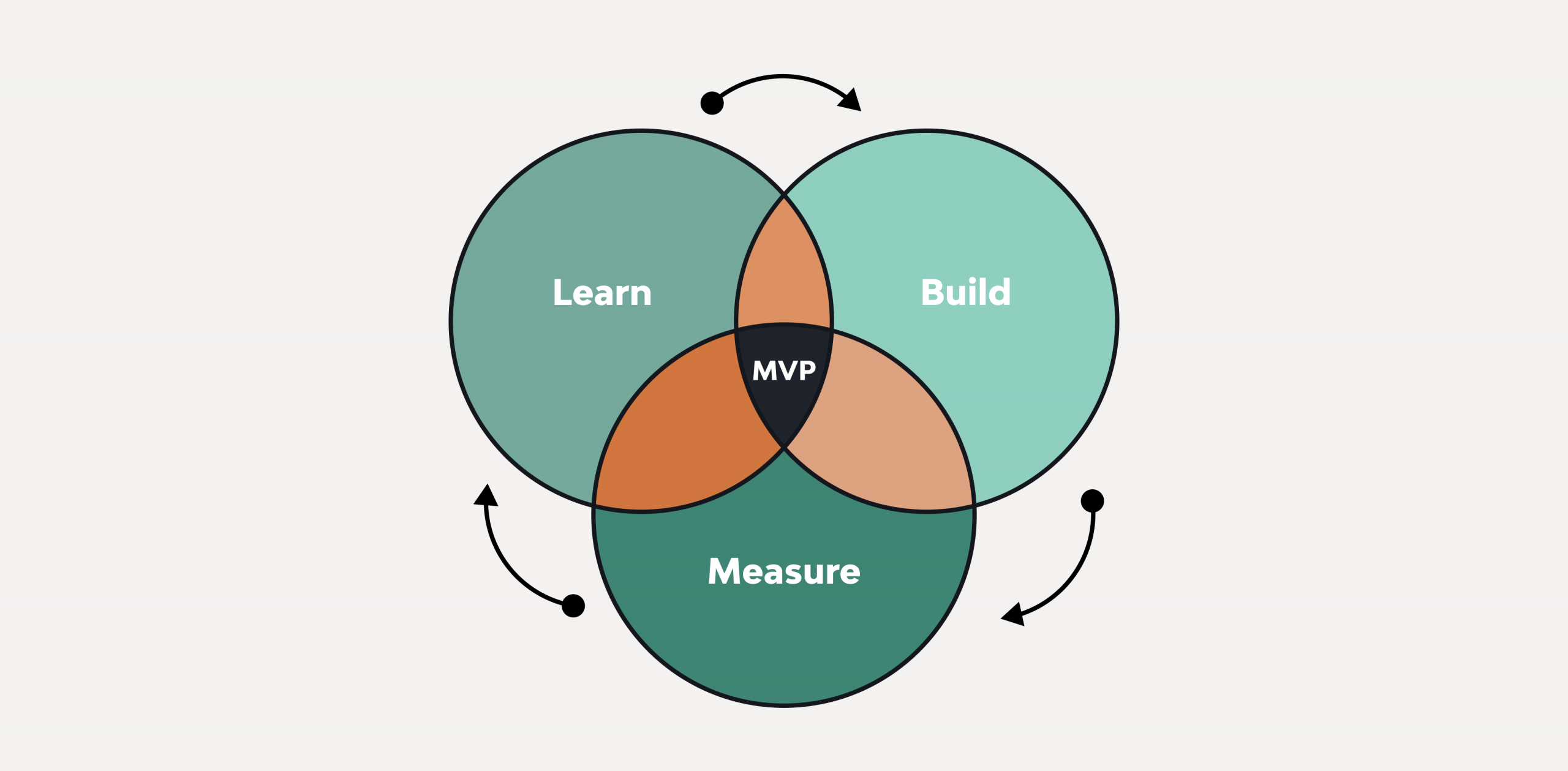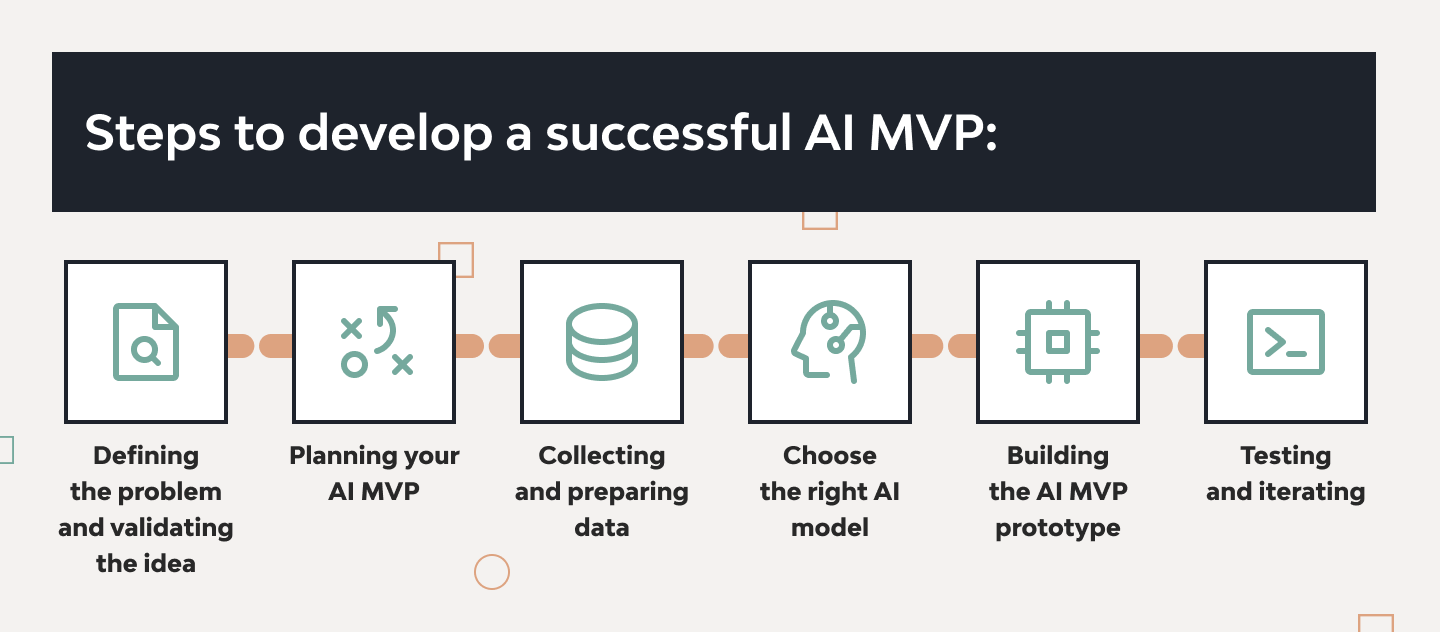AI MVP Development Guide for Startups

As you may already know, an MVP phase allows creating only the most basic version of the new software for testing its applicability and viability—a minimum viable product. With the advent of AI, more and more startups rely on this well-proven stage, seeing how their AI MVP looks and runs in the real world before implementing its more complex parts.
The AI MVP phase gives developers that precious time in between—right after early concept planning but just before full-on development—to test the waters and optimize more insightfully.
To build an AI MVP, startup owners need qualified contractor developers. At Django Stars, among our clients are AI-based MVP examples such as PADI Travel, which raised $1.4 million in funding, and Molo Finance, which raised over $270 million. Having worked with numerous startups, we created this guide to help you figure out the principles behind creating successful AI MVPs.
Benefits of building an AI MVP
While similar to regular MVP projects, MVP development workflow with AI can deliver significantly greater value. But freshly integrated, early AI models require more calibration and perfection (with time and data). There are more differences between launching an MVP phase and a traditional product cycle:
But the most outstanding thing is all the benefits you get:
Faster time-to-market and validation
With an AI MVP, you can validate the concept fast, sometimes in weeks, instead of the months spent building a complete system. This compression of time lets you collect real usage data before large-scale development.
Reduced development costs and risks
The MVP phase gives you time to decide whether you need a ready-made solution for a rapid AI MVP launch or custom software development services for startups with more depth and authenticity.
Early user feedback for product improvement
The qualitative and quantitative insights gathered during the MVP phase can be used to teach and adapt the AI model to a particular user flow. You can do that before putting it on a fully functional backend.
Focused solution to core problems
The early-stage AI product validation is built around a single high-impact user pain or issue. No unnecessary features, no excessive focus, and no empty value. An MVP phase zeroes in on real pains and solutions.
Ability to pivot based on real user data
Because the AI MVP continues to collect real usage and performance data, you get much more room for pivoting decisions mid-project, based on concrete data rather than your gut feeling alone.
Building stakeholder confidence
A functioning, user-tested AI MVP is a great pitch and demo to impress investors and executives. They get to touch and feel your concept, engaging with it firsthand and making experience-based decisions.
Step-by-step: How to build an AI MVP
As you can see, timely AI prototype development and testing as part of an AI MVP phase can save you lots of headaches and give you loads of data to benefit all further project stages. But beyond simply realizing these benefits, it’s important to understand the ins and outs of AI-powered MVP development.
Here’s a step-by-step AI MVP process to guide you through the typical development cycle:
#1 Defining the problem and validating the idea
Technology you’ll need:
- Zoom or Slack + transcription tools, like Otter.ai, to record and analyze live user interviews — essential for validating real pain vs. assumptions.
- Figma or Adobe XD for clickable wireframes and UI testing.
Before diving into AI and ML development services, forming a team, and setting up a tech stack, you first need a defined concept. Make sure you dedicate an MVP to the pain point that exists and is relevant. Conduct customer interviews or market research to confirm that, if needed.
#2 Planning your AI MVP
Technology you’ll need:
- Airfocus or Productboard for AI-enabled roadmapping and prioritization of features.
- A collaborative whiteboard, like Notion.
- Simple sheets, like Excel or Google Sheets.
Narrow down your AI MVP development needs with initial planning. Choose one feature that delivers core value and can be powered by AI. Lay out user touchpoints and expected outcomes. Prioritize tasks and document all decisions and information in the backlog or record.
#3 Collecting and preparing data
Technology you’ll need:
- Data labeling/annotation platforms, like Label Studio or SageMaker Ground Truth.
- Jupyter notebooks, Pandas, or simple SQL queries.
- Open datasets, like Kaggle or Hugging Face, or data synthesis.
An efficient MVP AI can only be brought up with good data — high-quality samples that reflect your target use cases. You need to gather, clean, label, and sample it wisely. If data is scarce, you can use a rules‑based system or a human‑in‑the‑loop workflow.
#4 Choose the right AI model
Technology you’ll need:
- Scikit-learn or XGBoost.
- Hugging Face Transformers or OpenAI.
- Or no model at all: use rule-based logic + “fake-AI” staging.
You’ll need to select an AI model to build upon and integrate into the MVP. If you’re working with a small volume of well-structured data, a regular ML model may do just fine. But for more advanced tasks (like NLP), you’ll need to use a smaller language model and fine‑tune it.
#5 Building the AI MVP prototype
Technology you’ll need:
- Django, FastAPI, or Node.js for backend and APIs.
- React / Vue or Bubble / WeWeb (for no-code frontends).
- ChatGPT Playground or Gemini Studio for testing AI responses before integration.
You need to design a basic UI structure (like a web app or even a single mobile screen) and develop the fitting backend to run it. To speed things up and stick with the conditions of AI integration in the MVP, use fast-tried frameworks or low‑code platforms where possible. It’s better to stay quick and get something in front of users, even if the UI isn’t “too beautiful yet.”
#6 Testing and iterating
Technology you’ll need:
- Hotjar, FullStory, or user session recordings.
- Optimizely (A/B and split testing).
- SurveyMonkey, Typeform.
The nature of AI MVP development must remain iterative:
Deploy to a small set of early users → Track accuracy, latency, and qualitative feedback → Listen to both technical and UX insights from real usage → Based on results, tune the model, improve prompts, refine UI, or reduce latency.
Repeat the cycle quickly to keep the feedback loop efficient.
#7 Measuring success and next steps
Technology you’ll need:
- Datadog, New Relic, or Neontri’s analytics tools.
- Google Analytics and in-app trackers of usage and feedback loops.
The ultimate success of your AI-driven startup MVP is in metrics. Here’s what you should measure mid- or post-MVP phase and before the product launch:
- Performance scores:
- precision
- recall
- Usage metrics:
- response rate
- drop-off
- Conversion goals
- user satisfaction
- qualitative feedback
- ROI
Once you achieve regular usage metrics or a real user count, you can start planning further product scaling. But the exact moment of the next big iteration should be decided by a professional (and tracked continuously in the future).
Challenges and considerations in AI MVP development
While still relying on many traditional tools, like programming languages and frameworks, AI MVP development sets itself apart from other projects with its core focus on smart technology. This comes with its challenges.
Data quality and availability
When building AI MVP for startups, you must rely on data that is accurate, representative, unbiased, and sufficient in volume. Fragmented, incomplete, or skewed data results in unreliable output, such as poor predictions or misleading analyses and suggestions. You must acquire a good, targeted collection of, preferably, labeled data beforehand.
Over-engineering or under-delivering
Teams often either overbuild features that are not needed in an AI MVP or strip the solution so much that it offers no value. This is where you’ll need to find the sweet spot — just enough model complexity, just enough UI. Avoid building heavy pipelines when you can test value faster with a simpler approach, building up a more straightforward MVP AI model.
Model explainability
AI models can be black boxes, which can easily intimidate stakeholders. During AI-powered MVP development, make sure to use interpretable algorithms where possible or integrate explainability tools, like SHAP or LIME. You’ll earn the most user and stakeholder trust simply by being able to explain why the model predicted what it did.
Integration with existing systems
An MVP AI can’t run alone. It must fit into users’ workflows — e.g., via APIs, webhooks, plugins, or simple email deliverables. There simply can’t be any room for poor integration, which depends mostly on the expertise and experience of your tech partner.
Tools and technologies for AI MVP development
There is a lot of baseline required tech described above. However, below is a list of traditional and AI tools for MVP development that should make a stack sufficient for any scale of an MVP AI project.
- Programming languages: Java, C++, Python, R, Scala, Julia, Lisp, MATLAB.
- AI/ML frameworks: TensorFlow, PyTorch, Scikit-learn, Keras, Hugging Face Transformers.
- Cloud AI platforms: AWS SageMaker, Google Vertex AI, Azure ML.
- Data tools: Pandas, NumPy, Airflow, MLflow (for tracking), DVC (data version control), Jupyter.
- MLOps tools: MLflow, Weights & Biases, Kubeflow
- DevOps tools: Docker, Kubernetes, GitHub Actions.
- Rapid UI/UI-API: React, Angular, Vue.js, Bootstrap, Streamlit, no-code platforms (e.g., Bubble).
- Visualization: Plotly, Power BI.
As much as these tools are well-proven, it’s best to turn to personalized software development consulting services to set up a unique AI technology stack for startups with a custom structure.
When and how to scale your AI MVP: Key metrics
The only thing more important than knowing how to build an AI MVP is learning how to complete and evolve it. To achieve scalable AI MVP solutions, you must know when the perfect time to scale is. For this, pay attention to two sets of metrics:
Business metrics
To decide whether to scale your AI MVP, monitor key indicators like:
- User engagement (e.g., number of active users)
- Retention (e.g., repeat engagement rate)
- Product‑market fit (e.g., positive UX impressions)
- User conversion (e.g., subscriptions or in-app purchases)
- User satisfaction (e.g., positive feedback)
- Value delivered per user (e.g., user acquisition cost vs. value delivered)
If your AI MVP achieves sustained usage and low churn, with signs of positive ROI, it’s time to expand.
Technical or AI metrics
From the technical and AI model side, measure these:
- Model accuracy (e.g., precision, recall, and F1)
- Inference latency (e.g., data drift)
- Error rates in production (e.g., retraining instances)
- Uptime (e.g., API response time)
- System stability (e.g., performance under stress)
- Scalability of data pipelines (e.g., speed of AI model scaling)
If these metrics stay within acceptable bounds as user volume grows, your infrastructure can withstand a greater load. However, scaling too early, before these metrics hold up, can burden the system and worsen your MVP AI’s user experience.
How Django Stars helps AI startups build effective MVPs
MVP development for AI is an innovative niche of its own that requires unique tools, techniques, and qualifications. Django Stars gives you the expertise you need to take on that technical complexity, delicate data operations, and in-depth tech decisions.
There’s a lot more you gain with our expertise:
- We provide end-to-end product sprints: From problem analysis and AI use-case identification to MVP design, development, deployment, and post-integration support.
- We help structure data pipelines and labeling workflows: If data is sparse, we can help integrate rule-based or human-in-the-loop support layers until the required model confidence is reached.
- We build the frontend/backend MVP stack using Django and FastAPI: Quick to launch, easy to scale, and equipped with native authentication, admin dashboards, and data integrations (e.g., external APIs, Excel/CSV).
- We help interpret results and build explainability dashboards: For instance, feature-level insights and attention maps for stakeholders to understand AI model output.
- We support iterative feedback loops: The MVP-first approach allows us to integrate early user feedback into the product and make AI adjustments within short cycles.
- We provide post‑MVP roadmapping: If the AI MVP performs according to business and technical metrics, we help you plan the next efficient milestones.
Django Stars combines agile custom MVP development and AI Proof of Concept for startups, AI training and integration, cross-functional teams, and deep Python expertise to help you launch startups that learn quickly and scale smartly.
If you need help choosing AI tools for MVP creation, consult the next step, or organize lean AI product development — turn to specialists.









